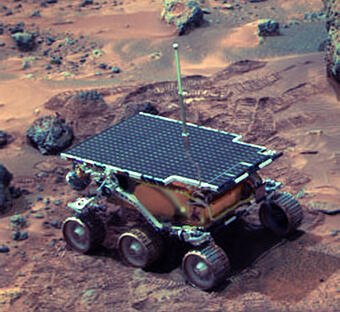This month in history: In memory of the first rover to rove on Mars
This month marks 27 years since the successful landing of NASA’s Mars Pathfinder spacecraft, including Sojourner, the first-ever robotic rover to land on Mars.
The word “sojourner” means “temporary resident, guest, visitor, or traveler.” But the name for the rover was chosen to honor Sojourner Truth, a Civil War era African American abolitionist and women's rights/civil rights activist.
This month reminded us of the first-ever rover to land on Mars’ surface. The Mars Pathfinder mission launched on December 4, 1996. On July 4, 1997, the lander touched down in Ares Vallis, a target of geological interest identified by analysis of data from the Viking orbiters. Sojourner, hitching a ride in the belly of the pyramid-shaped lander, had a wild ride to Mars, ultimately bouncing on the surface, protected by an array of airbags.
On July 4, 1997, Sojourner touched down in Ares Vallis as part of NASA’s Mars Pathfinder mission. Sojourner would be investigating a theorized ancient flood that likely swept a diversity of rocks and dirt together, piquing scientists’ interest in the rocks’ compositions, to learn more about Mars. The day after landing, the six-wheeled, solar-powered rover, about the size of a microwave oven and outfitted with various scientific instruments, was off to investigate the local geology.
On July 4, 2024, America celebrated 243 years of Independence from Britian. Additionally, Astrogeology Science Center (ASC) observed the first-ever rover to trailblaze Mars’ surface, as touchdown was set to occur on Independence Day of July 4, 1997–some 27 years ago. The successful landing and operation of Pathfinder on Independence Day added a sense of national pride and celebration to the mission.
Sojourner was designed to operate for just seven sols (Martian days), possibly up to 30 sols. Ultimately, the mission operated for 83 sols, and traveled more than 100 m.
Numerous Astrogeology scientists worked on the Mars Pathfinder mission. So, as much of our country celebrates Independence Day, Astrogeology also celebrates this trailblazing little rover with an added sense of national pride and celebration. This historic event highlights the remarkable capabilities of NASA’s engineering and technology and symbolizes the spirit of planetary exploration. We are reminded of the pioneering spirit that has driven humanity to explore new frontiers throughout history.
Viking Orbiter data provided the information necessary to discover the ideal target. Sojourner successfully touched down in Ares Vallis and roved to the ancient riverbed, thought to have formed by a catastrophic flood. She captured detailed images of the Martian surface and transmitted these data back to Earth, at a time when the internet was still in its infancy. She also conducted experiments to analyze the composition of rocks and soil, providing our first look at the geological history of Mars from the surface. The Mars lander, from where the rover emerged, collected information at the landing site about atmospheric conditions, the surrounding terrain, and captured those great shots of Sojourner.
Do you know that scientists at Astrogeology still use data from past Mars missions to plan future missions? We download, process, archive, and serve such data to the international planetary science community to support scientific studies, STEM education, and general public interest. If you would like to learn about the general geology and geomorphology of the Mars Pathfinder landing site, you are welcome to explore our data here.
Get Our News
These items are in the RSS feed format (Really Simple Syndication) based on categories such as topics, locations, and more. You can install and RSS reader browser extension, software, or use a third-party service to receive immediate news updates depending on the feed that you have added. If you click the feed links below, they may look strange because they are simply XML code. An RSS reader can easily read this code and push out a notification to you when something new is posted to our site.


